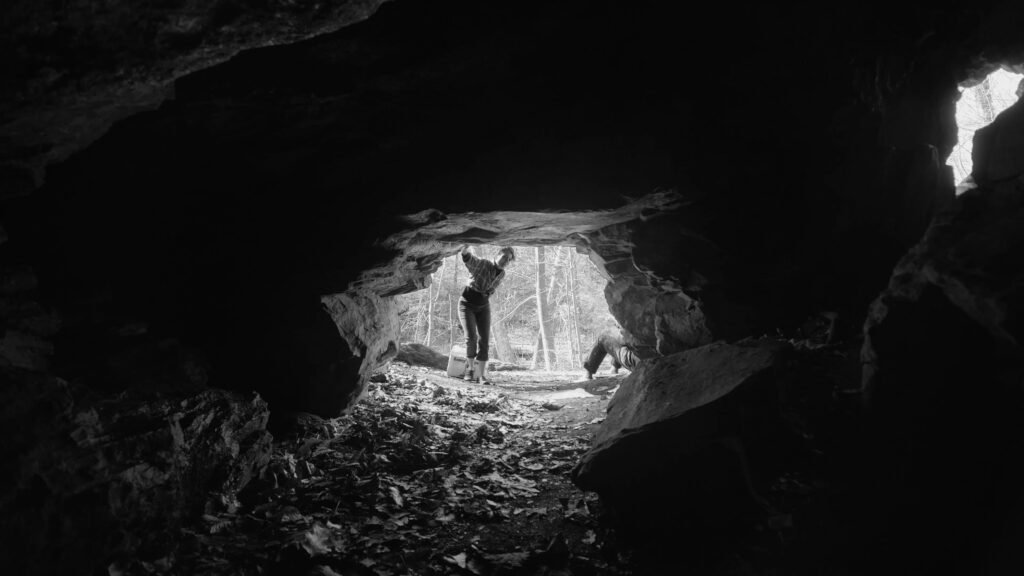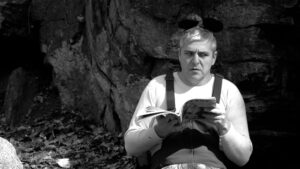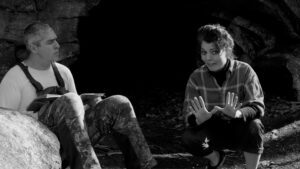 UPDATE, April 2023: Osceola is now available to watch via streaming, on Tubi! How did we do this? The story’s at the very end, under “Post-Production.”
UPDATE, April 2023: Osceola is now available to watch via streaming, on Tubi! How did we do this? The story’s at the very end, under “Post-Production.”
About a year ago, I did the last round of shooting nature footage at the Wissahickon Creek, for my project The Wissahickon Creek (available on streaming on Amazon Prime, Tubi, and other apps). At the time, I figured, I’d gone up there on-and-off for a few years, I’d shot a lot of the area, what I hadn’t shot was probably only as good as what I’d already shot, and I decided there and then: unless someone gave me a really good reason to drag myself back up there, I was frickin’ done with the place.
A few months pass, and Kyle Cassidy wanted to turn a play into a movie (again), and it was a play written by and starring John Rosenberg and also starring Jennifer Summerfield (again). The play is Osceola, which takes place in front of an abandoned mine entrance in 1966. Philadelphia’s a little short on abandoned mine entrances– we’re also short on whiskery prospectors, mule trains, and claim jumpers– so we decided to do a quick’n’dirty shoot… at a cave at the Wissahickon Creek.
So one Sunday morning, we drove up there and shot the play. It took only a few hours, because we shot the full performance with three cameras, and then we did some pickups and specific shots afterward. And thanks to the COVID quarantine (which focuses one’s attention admirably), I was able to turn it into a full video inside of three weeks. During which, Kyle suggested changing it to black-and-white, and he and Jen lined up Molly Robison to contribute a version of the old standard “Perhaps, Perhaps, Perhaps.”
I’m no good at describing the experience of filming– everyone’s focused on what they have to do, and as far as I could see, we all had a good time doing hard work. But, I can talk about the techie stuff for my fellow videographers.
Workflow
I think I’ve nailed down a good workflow for handling these multicamera shoots in Premiere Pro.
Step 1: Import the materials, and sync them all on a single “Synced Materials” timeline.
This is basically lining up the video and audio tracks so they play in synchrony. Not all the tracks line up perfectly– you get some odd echoes if the tracks are more than half a frame out of sync– but the audio can be adjusted in tiny increments.
Step 2: Create a “Multicam Edit” sequence from the “Synced Materials” timeline.
The “Synced Materials” multicam clip went onto the first track, and I was able to go through the full performance and do an edit. I then took the inserts and pickups at the end, and placed them on Track #2, and dropped them in as inserts.
It really helps that Adobe’s fixed a long-standing problem, i.e., no visible audio waveforms on multicam clips. Now they’re visible, and that makes editing much easier. There’s a bit of trickery when you have two multicam tracks, but it can be done.
Step 3: Fix the Sound
Make a copy of your “Synced Materials” timeline, and adjust your audio levels and quality on the copy. Export the final as a single audio file. Re-import this into a new audio track on the “Synced materials” timeline, preferably Track 1. Now, go to your multicam timeline, unlink the video and audio, and change all the audio segments so they point to Track (Camera) 1. So now your multicam edit has the final soundtrack. (You may have to adjust the track to get it in sync: there’s a bit of drifting that happens with PP.)
Black and White
We shot this in color, and had intended to use color. But we went with black and white mainly because the three cameras we used– Panasonic GH5s, GH4, and GX9– had very different exposures. It looked much nicer anyway– and this story took place in 1966, when some great black-and-white cinematography was being done by the likes of James Wong Howe (Hud) and Haskell Wexler. And by using the RGB sliders with the black-and-white effect, one could adjust the greyscale selectively: boosting the reds brightened up faces, for example. (If I removed the black-and-white effect, some of the footage would look really oversaturated and electric.)
The Conversation
This job also gave me an excuse to experiment with some new equipment, namely, the Tascam DR-10L Portable Digital Audio Recorder with Lavalier Microphone. Normally, I’ve had to rely on my Rode camera mikes, and on occasion, my Zoom H4n Pro recorder. And they’ve been effective, but they tend to capture all the noises, and things like room echo that make video productions sound cheap. For real audio, you want to have the voices isolated from everything else. It makes editing easier, and you can adjust the quality for the scene, and you can layer in background, ambient, and incidental sounds.
The Tascam DR-10L is a small, wearable recorder, about an inch-and-a-half square, that clips to one’s belt. You attach a lav mike, start the recorder, and you’re good for up to eight hours. This time, using two Tascams would give me soundtracks that were (mainly) just the actors’ voices. Giving me some freedom and some control over quality in post. Zoom makes one that’s like it, the Zoom F1-LP (and yeah, I know, Curtis Judd likes it more). But there are downsides to this kind of recorder.
You have to hide the recorder and the lav mike on the actor, for one thing. I shoot a lot of stage plays, and even if I had a Tascam for each actor, it’d be a huge imposition to ask each one to wear one of these. Happily, this was a two-actor play, so I only had to buy a second Tascam to do this.
But the big drawback is that you can’t adjust the levels or monitor the signals during shooting. These aren’t wireless mikes: they’re tiny recorders. You basically set the thing, start recording, and hope for the best. (And sometimes, the mikes or even the recorder can be seen in the video.) But the Tascam has a safety feature that the Zoom doesn’t. It can record two simultaneous tracks– one at normal level, and the other, at 6 to 12 decibels below the other. Thus, if you set the recording levels too high or low, then one of the tracks will be usable. Or, if you get it right, you can balance the two tracks in post and pick and choose which bits work best. But it’s still a bit chancy. I’d tried the Tascam on a one-actor show, and messed up the recording levels. This time, I consulted with the Web and used Matt Johnson’s recommended Tascam settings for the project.
Low-cut: on
Limiter: on
Auto-level: On
FS sample: 48khz
File type: mono
Dual Rec: -12dB
MP3 mode: off
Track Inc: on
Warn Beeps: off
Power Save: on
Name Type: date
Mic Bias: on
So how did it turn out? At first I was disappointed. The main tracks were very loud, frequently peaking, and the lower-level tracks were pretty low. It also sounded a bit thuddy and muffled, which I chalked up to using the mikes that came with the recorder. John’s tracks had a lot of clothes rustling, but that’s always a risk with lav mikes.
In the future, though, I think I’ll set the Mic Gain to Low, and the Dual rec level to -6dB. That may reduce the peaking of the main tracks, and raise the lower tracks so they’re a little more powerful. I’ll probably ask Matt Johnson for his p.o.v., but any advice on this’d be admired.
Most of the sound is Jen’s monologue. I took her tracks, and adjusted the levels so they more or less matched each other. (It wasn’t just raising one by 6 db and lowering the other by 6db, but that’s the general idea.) Running together, they sounded fairly OK. A little boosting in the vocal ranges of the equalizer, and it was suddenly much clearer. It was still a bit flat for an outdoor recording, but adding a hint of studio reverb gave it the feel of an outdoors recording. And best of all, it rarely picked up the extraneous noises– for the most part, the track was Jen’s voice and the barest hint of forest noise. So if I had to remove a sound– like the guy who shouted “FUCK!” from across the gully– it came out without a problem.
As for John’s tracks… well, I took the lower-level track, and isolated every sound of importance– which meant a lot of seed-spitting_phthew!_ sounds. When he actually spoke, I didn’t need his higher-level track.
There were two more advantages to recording like this. The first was that I could substitute any background ambient sounds I wanted. I had some ambient sound tracks from my Wissahickon project– which were recorded in late summer, not late winter like the location was– so I dropped that in, and sprinkled in some bird sounds I’d isolated from that project. The result was… well, pretty good, to my untrained ears.
The other advantage was that I could take Jen’s vocals, and move them in stereo, left to right, to match her position on screen. This might be great for surround-sound fans. We didn’t use this ability, in the end, but it opened up some interesting possibilities.
(By the way, a few years ago, I bought a Behringer X-touch mixing board for use with Premiere Pro. It’s a nice piece of equipment, but frankly, it didn’t help me at all in this project. Sound engineers are probably more used to mixing things “live,” moving the sliders and knobs as the recording’s happening. But I’m more used to going over the adjustments a few times. It didn’t help that there’s no real guide to using the Behringer with Premiere Pro, and maybe the interface just isn’t that great. So I might sell it.)
Post-Production for Streaming Video
 Originally, Osceola was released to YouTube, for free, mainly to share the play and the performances with our various friends, acquaintances, and possible professional contacts. But the COVID pandemic and quarantine were, among many things, good motivators to get jobs done.
Originally, Osceola was released to YouTube, for free, mainly to share the play and the performances with our various friends, acquaintances, and possible professional contacts. But the COVID pandemic and quarantine were, among many things, good motivators to get jobs done.
I’d used Filmhub to place The Wissahickon Creek with streaming services. There were two reasons why we couldn’t do this with Osceola. The first problem was that distributors like Filmhub require that the film have a Closed Captioning track, so that the hearing-impaired can enjoy the show as well. And I was too lazy to transcribe the film and match it to the proper timecodes. Well, Adobe fixed this problem for me– sometimes in 2021 or 2022, they added a feature that would transcribe video, and create the captions track. It’s not perfect, but it’s pretty good, so I put in the work and spent a few weeks cleaning them up.
The second problem was that we’d used copyrighted music: not only does Jen’s character recite the lyrics to “Perhaps, Perhaps, Perhaps,” but Molly Robison had performed a cover version for our titles. (The song is actually titled “Quizas, Quizas, Quizas.” It was written by Osvaldo Farres, and the Engligh lyrics were by Joe Davis. You may recognize it as the theme from the British sitcom Coupling.)
Now, we had no conception of how music licensing works. For all we knew, it might cost us more than the entire production did (which was next to nothing), and it might be so expensive that we’d never recoup the costs. Well, it didn’t hurt to get informed, and we had COVID time to spare, so I spent a few weeks tracking down the copyright holders. I wrote, explained our situation, and asked what it would cost to license “Quizas, Quizas, Quizas” for our video project. Again, we got a wonderful surprise: the company quoted us a number that was extremely reasonable: that is, we could pay for it and have a reasonable chance of earning it back.
After that, it was just a matter of entering the film’s cast-and-crew data into Filmhub’s database, and into the Internet Movie Database so we all look like movie stars. I made the final submission in January 2023. Filmhub approved it a few weeks later. In mid-February, they said that Amazon and Tubi had accepted it. It wasn’t until late March 2023 that Tubi actually released it. Which is pretty cool: a one-day shoot, some post-production labor, and now we all have an actual movie that’s been released professionally.
(Just to share something with y’all about streaming and money. Amazon doesn’t pay squat. I have no idea how many people watched The Wissahickon Creek through Amazon, but I’ve never received more than three dollars in any given month from them. So their massive customer base doesn’t translate into riches. Tubi, on the other hand? I don’t know why, but during 2022, it was netting me close to a hundred dollars a month sometimes. I don’t know if this is due to more viewers, or Tubi’s internal business structure. All I know is, when I saw that Osceola was on Tubi, I could reasonably expect to net some money for John, Jennifer, and Kyle in the next few months.)



